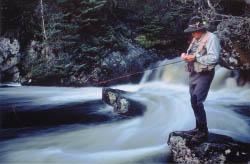CDC/Soft Hackle Hybrids

By Chris Marshall
Tradition
Soft hackled wet flies have been around a long time. When I first began to
dabble in fly fishing on the brooks and dales of the Yorkshire Dales fourty-five
years ago, they were the standard patterns. Even during a hatch, almost all
local fly fishers used soft hackles floated in or just below the surface film,
rather than Halford style dry flies which were de rigeur on the gentler rivers of
the south.
The soft hackles used by Dales fly fishers in the 1950's were little changed
from those described in Yorkshire fly fishing books of the previous century.
In fact, the basic concept of the soft hackled wet fly is ancient, and was
already an integral part of a well-established tradition long before the first
recorded attempts at describing the patterns began to appear in print over
500 years ago.
These simple but elegant flies are just as effective today as they were half
a millennium ago. And why not? They embody the culmination of generations
of keen observation and practical inventiveness. They were designed to match
the hatch - not as exact imitations which we have come to associate with modern
dry fly fishing, but as suggestive, impressionistic creations which simulated the
general shape, the colour, and the movement of the fly in water.
Soft hackles are also very versatile, in that one fly could be used to imitate the
emerger, the dun, crippled and drowned duns, and the spinner simply by varying
presentation. However, the early practitioners of the art were acutely aware
that flies trapped in the film were usually more effective than those floating on
the surface. This came from careful observation of the natural insect. "If the day
be warm, the insect takes flight immediately on reaching the surface of the
water; but if, as is commonly the case, the day is cold, it hinges on the surface,
not completely hatched into perfect form, and is thus easily pounced upon by
the expectant trout." Pritt, T.E. North Country Flies (London,
1886).
They were also aware that it was important to fish the artificial as a living
insect. Ronalds in A Fly Fisher's Entomology (London, 1848)
claims that this is "best accomplished by throwing across and down the current;
the top of the rod . . .after throwing, be held over the side of the stream,
on which the fisherman stands ready to strike; the current will then act on
that part of the line lying on the water and cause the fly to sail over toward
the same side, yet still float down a little, as a natural fly when struggling might
be supposed to do." This is the classic downstream wet fly technique.
Innovation
In its traditional form, the soft-hackled wet fly is an extremely effective and
versatile pattern. However, when combined with a CDC wing, it is even more
versatile. Adding a CDC wing behind the soft hackle provides variable
buoyance. When cast with a traditional wet fisher's open loop, the CDC
retains water and the fly will sink into or beneath the film, but when it is blow
dried with false casting, the CDC makes the fly float. The combination of the
"living" soft hackle and the variable buoyancy is deadly, for, as well as
imitating naturals in and below the surface film, it also allows the anglers to
imitate the fully-hatched dun without changing flies. Varying the density of the
CDC wing provides a range of flies from those which are more sinkers than
floaters to those which are more floaters than sinkers.
Fishing the CDC Soft-Hackle
Like the traditional soft-hackle, the CDC version is most effective during
a hatch. It can be fished in the classic across-and-down technique to rising
fish, especially on windy days when flies are being blown about on the
surface of the water - when a few non-purist twitches can often help. It
can also be fished dead-drift either across or upstream. Even some of the
soft-hackle practitioners of the last century used this dry fly technique
when the across-and-downstream presentation failed them. In every
situation, the critical aspect of presentation is varying the tightness of the
casting loop so that the CDC wing fly has the appropriate degree of positive
or negative buoyancy when the fly hits the water. ~ Chris Marshall
Books by Yorkshiremen on Soft Hackled Flies
Edmonds, H.H. & Lees, N.N. Brook and River Trouting, Bradford, 1916.
Jackson, Hohn. The Practical Fly Fisher, George Harrison, Bradford, 1853.
Kirkbridge, John. The Northern Anglers, Bradford, 1855.
Pritt, T.E. The Book of Grayling, Leeds, 1888.
Ronalds, Alfred. A Fly Fisher's Entomology London, 1849.
Theakston, Michael. British Angling Flies, London, 1883.
Note: I realize that Ronalds was unfortunate enough not to have been born a Yorkshireman,
but he was thoroughly familiar with Yorkshire fly patterns, and his A Fly Fisher's Entomology
is by far the most significant work of the century on both the natural and artificial flies of the
whole of England. As most of the above titles are not readily available to most readers, we will
publish relevant text and drawings on our website
sometime soon. Check it out.
|
 Next time:
Next time:
A traditional Soft-hackled wet fly, the Waterhen Bloa and the CDC version.
We thank the
Canadian Fly Fisher for re-print permission!
Our Man In Canada Archives
|



 Next time:
Next time:


 Next time:
Next time: